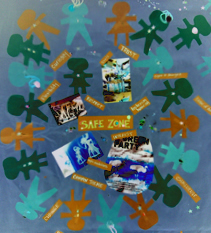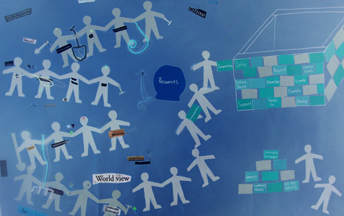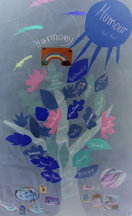In the last year of the study, we brought more people
into the process of analysis-through-discussion at a symposium.
Just as we had begun to see the Researchers
and the Lifelong Learning Working Group as learning circles, we
saw the symposium as a learning circle, one that widened the process
of analysis-through-discussion. We
called the symposium Widening the Circle.
The
symposium brought together sixteen participants representing three
rural learning circles, two Indigenous learning circles and four urban
learning circles. This
group also included members of the Working Group, the Researchers, a
staff person from the Federation of Women’s Institutes of Ontario
and faculty and researchers from the Centre for Aboriginal and Indigenous
Studies at the Ontario Institute for Studies in Education of the University
of Toronto.
We decide to facilitate the symposium using the approach
to learning and knowledge creation that we had observed in the learning
circles. We
did not tell the participants that we were going to do this, but
they soon recognized what was happening, leading to this exchange between
Maria Matias, a learning circle facilitator, and Arthur Bull, as
he facilitated one of the sessions.
Maria: Do you know what
I felt yesterday and today? This has been a very positive experience for me, because
I found that when we came together, it was . . . The group is kind of,
was set up, you know, whoever organizes things, on ones such as simplicity,
acceptance, take it as it is. Because there wasn’t these
expectations, you know, you know how sometimes you go into a group or
a situation and there is these expectations of this professionalism,
of this or that or the other, and then you feel, oh, am I going to be
able to meet that level, so I’m not going to do anything at all
and be vulnerable. Because in here it was based on just be as,
come as you are and be as you are and all of that, then all of us, all
right, would just be as we are, but then grow a little more from the
experience.
Arthur: I think you’ve found us out, because
this is . . . We thought, “How do you find out about learning
circles? You do it with a learning circle.”
At
the symposium, all of the participants in the circle brought knowledge
about learning circles. Members of learning circles brought knowledge
from the experience of participation in the various circles. The
Researchers and members of the Working Group brought knowledge from their
involvement in the project, against the background of their discussions. At
the symposium, these kinds of knowledge were negotiated. At
the symposium, these kinds of knowledge were negotiated. The result
is on this website where you can read from the transcripts of the symposium and see the posters which the participants made. You will also find the results of what the researchers learned at the symposium reflected in the:
- the recommendations about
how governments and communities can support learning circles
- our overview of the impacts of
learning circles
- our overview of how inclusion works
in learning circles
- the Beginner’s Guide,
especially chapters 9 and 10















 National
Literacy Secretariat
National
Literacy Secretariat 

 NALD
NALD